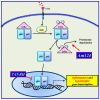NFkappaB is a Key Player in the Crosstalk between Inflammation and Cardiovascular Diseases
- PMID: 30935055
- PMCID: PMC6480579
- DOI: 10.3390/ijms20071599
NFkappaB is a Key Player in the Crosstalk between Inflammation and Cardiovascular Diseases
Abstract
Inflammation is a key mechanism of cardiovascular diseases. It is an essential component of atherosclerosis and a significant risk factor for the development of cardiovascular events. In the crosstalk between inflammation and cardiovascular diseases, the transcription factor NFκB seems to be a key player since it is involved in the development and progression of both inflammation and cardiac and vascular damage. In this review, we deal with the recent findings of the role of inflammation in cardiac diseases, focusing, in particular, on NFκB as a functional link. We describe strategies for the therapeutic targeting of NFκB as a potential strategy for the failing heart.
Keywords: GRK; NFκB; cardiovascular diseases; inflammation.
Conflict of interest statement
The authors declare no conflict of interest.
Figures



References
Publication types
MeSH terms
Substances
LinkOut - more resources
Full Text Sources

